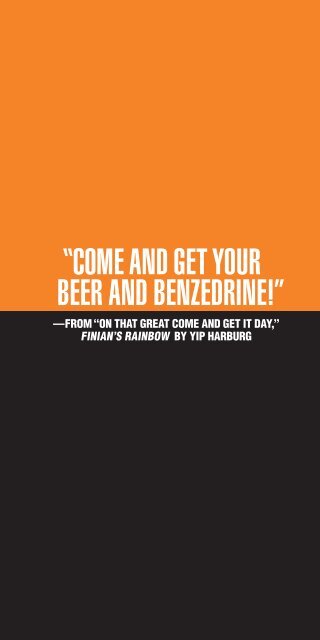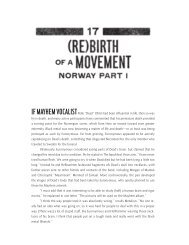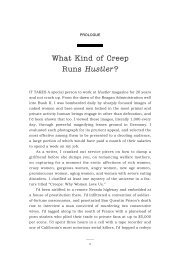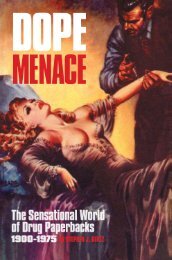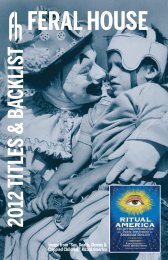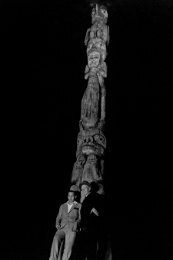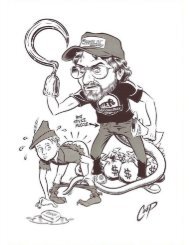“Come and get your beer and benzedrine!†- Feral House
“Come and get your beer and benzedrine!†- Feral House
“Come and get your beer and benzedrine!†- Feral House
Create successful ePaper yourself
Turn your PDF publications into a flip-book with our unique Google optimized e-Paper software.
“Come <strong>and</strong> <strong>get</strong> <strong>your</strong><br />
<strong>beer</strong> <strong>and</strong> <strong>benzedrine</strong>!”<br />
—from “on that Great Come <strong>and</strong> Get It day,”<br />
fInIan’s raInbow by yIp harburG
a fast history of amphetamine ● speed-speed-speedfreak<br />
by miCk farren<br />
<strong>Feral</strong> <strong>House</strong>
1 ● A Drug in Search of a Function ......................................... 7<br />
The Science of Speed ..................................................................... 9<br />
Artificial Paradise .......................................................................... 15<br />
2 ● Speed for the Super Soldier ............................................ 22<br />
“Issue the Drugs!” ........................................................................ 26<br />
More Science of Speed ................................................................. 28<br />
Captain America <strong>and</strong> the Red Skull ............................................... 36<br />
3 ● Speed for the Leader ....................................................... 45<br />
BOX WITHOUT HEADLINE............................................................... 51<br />
The Kennedy Medication ............................................................... 53<br />
The Psycho-Civilized Society ......................................................... 56<br />
MKULTRA ...................................................................................... 61<br />
Mother’s Little Helper .................................................................... 65<br />
4 ● Methedrine Melodies ....................................................... 67<br />
Hank Did it This Way ..................................................................... 73<br />
5 ● “Speed Kills” .................................................................... 83<br />
The Family That Slays To<strong>get</strong>her ..................................................... 87<br />
Just Another Mouse in the Cage .................................................... 93<br />
Speed in the People’s Temple ........................................................ 94<br />
6 ● Speed of Angels ............................................................... 97<br />
Controlled Substances ................................................................ 102<br />
4
table of Contents<br />
7 ● Sex, Science, <strong>and</strong> a Line of Speed ................................. 107<br />
Skyrocketed! The Male View ....................................................... 111<br />
With his Fog, his Amphetamine <strong>and</strong> his Pearls ............................. 114<br />
X Marks the Spot ........................................................................ 119<br />
8 ● The DIY Fast Track ......................................................... 127<br />
Do No Harm ................................................................................ 133<br />
The Ice Cometh ........................................................................... 138<br />
Feds in the Kwik-E-Marts ............................................................ 144<br />
9 ● Enter the Amezcua Brothers ......................................... 147<br />
Don’t Mess with the Mexican Mafia............................................. 152<br />
10 ● The Epidemics.............................................................. 157<br />
The View from the Opposite Side 1 .............................................. 162<br />
The View from the Opposite Side 2 .............................................. 165<br />
Meth in the Megachurch ............................................................. 169<br />
11 ● The Third World Alternative ......................................... 171<br />
12 ● The Pornography of Information ................................. 181<br />
When an individual’s right to privacy collides with the<br />
pursuit of law enforcement, what should yield? ........................... 185<br />
National Methamphetamine Awareness Day, 2006 ...................... 193<br />
13 ● The Shape of Speed to Come....................................... 195<br />
5
The b<strong>and</strong> had graduated<br />
from pills to glass ampoules of pure liquid<br />
methedrine. The running gag among the<br />
musicians <strong>and</strong> roadies was that the only clinical<br />
use for the stuff, aside from fueling a ramshackle rock<br />
& roll b<strong>and</strong> from one performance hellhole to the next,<br />
was to revive patients who had clinically died on an<br />
operating table. We took a certain suicidally romantic<br />
pride in our advanced substance abuse—it was, after<br />
all, the late 1960s. We might not play as well or be<br />
as popular as The Who, but there was a good chance<br />
we were taking quite as much speed as they were, <strong>and</strong><br />
we figured that had to count for something. Some b<strong>and</strong><br />
members injected the drug, others, the ones with a phobic<br />
dislike of needles, simply cracked open the neck of the<br />
ampoule <strong>and</strong> poured it into a Coca-Cola or a Pepsi...<br />
—Mick Farren on The Deviants
a drug in searCh of a funCtion<br />
WHen basic aMpHeTaMine Was FirsT synTHesizeD<br />
in 1887 by the romanian chemist Lazar edeleanu, working<br />
at the University of berlin, no one was thinking about<br />
madness, death, or any combination of the two. The hope<br />
was that this new compound would prove an easily manufactured<br />
<strong>and</strong> more efficient bronchodilator for asthmatics<br />
than the drug ephedrine, which had been isolated from the<br />
plant ma huang that same year by nagayoshi nagai in Japan.<br />
edeleanu dubbed his creation “phenylisopropylamine,”<br />
but later switched its name to alpha-methylphenethylamine<br />
which was quickly shortened to the more pronounceable<br />
amphetamine. (as in alpha-methylphenethylamine.)<br />
From the very start, amphetamine proved itself to be<br />
a drug in search of a function. it had proved disappointing<br />
as an asthma cure, but it showed a quite amazing range<br />
7<br />
chapter 1
CHAPTER ONE<br />
of side effects. Test subjects exhibited alertness, euphoria,<br />
heightened physical energy, <strong>and</strong> prolonged stamina. in early<br />
tests, it enhanced concentration, caused rapid <strong>and</strong> volatile<br />
verbalization, boosted confidence, <strong>and</strong> increased social responsiveness.<br />
Other effects of the drug included decreased<br />
appetite, <strong>and</strong> a noticeable enhancement of the sex drive <strong>and</strong><br />
sexual response in both men <strong>and</strong> women. When, again in<br />
Japan, in 1919, the related but far more powerful crystallized<br />
methamphetamine was synthesized by a research team<br />
led by akira Ogata (via reduction of ephedrine using red<br />
phosphorus <strong>and</strong> iodine), commercial uses still could not be<br />
found, but it was noted that the same powerful side effects<br />
observed with the original amphetamine were even more<br />
pronounced in this advanced variation.<br />
at that point, the research on amphetamine was<br />
shelved, <strong>and</strong> it wasn’t until 1927 that pioneer psychopharmacologist<br />
Gordon alles resynthesized the drug, still<br />
seeking a substitute for the asthma cure ephedrine, but,<br />
again, it failed to fulfill its intended purpose. although to<br />
continue research on a drug without any immediate specific<br />
therapeutic goal is common in today’s pharmaceutical<br />
industry, such work was simply considered a waste of time<br />
<strong>and</strong> laboratory space in the early twentieth century. alles<br />
had, however, discovered that amphetamine could be produced<br />
in a volatile form that lent itself to packaging as an<br />
inhaler. This attracted the attention of the corporate pharmaceutical<br />
giant smith, Kline & French (sK&F), who decided<br />
that amphetamine could be profitably marketed as<br />
a means of relief for a whole variety of ailments. in 1932,<br />
the <strong>benzedrine</strong> inhaler was launched in drugstores in the<br />
United states, <strong>and</strong> was both prescribed by accommodat-<br />
8
a DrUG in searcH OF a FUncTiOn<br />
ing physicians, <strong>and</strong> sold over the counter, first as a general<br />
treatment for respiratory problems, then within less than<br />
three years, for relief of more than 39 medical conditions<br />
ranging from hiccups to schizophrenia.<br />
the Science of Speed<br />
AmphetAmines release stores of norepinephrine<br />
<strong>and</strong> dopamine from nerve endings by<br />
converting the respective molecular transporters<br />
into open channels. Amphetamine also releases<br />
stores of serotonin from synaptic vesicles when<br />
taken in relatively high doses. this effect is more<br />
pronounced in methamphetamine use. Amphetamines<br />
also prevent the monoamine transporters<br />
for dopamine <strong>and</strong> norepinephrine from recycling<br />
them (called reuptake inhibition), which leads to<br />
increased amounts of dopamine <strong>and</strong> norepinephrine<br />
in synaptic clefts. these combined effects<br />
rapidly increase the concentrations of the<br />
respective neurotransmitters in the synaptic<br />
cleft, which promotes nerve impulse<br />
transmission in neurons that have<br />
those receptors. ●
CHAPTER ONE<br />
WHiLe sMiTH, KLine & FrencH anD THe MeDicaL<br />
profession were extolling the virtues of <strong>benzedrine</strong>, a<br />
section of the ever ingenious public-at-large quickly discovered<br />
that the inhalers had an equally extensive nonmedical<br />
potential—essentially the range of side effects<br />
first observed by the researchers edeleanu <strong>and</strong> nagai—<br />
<strong>and</strong> began to devise ingenious ways to exploit them.<br />
The abuse of <strong>benzedrine</strong> inhalers required only minimal<br />
cunning. The inhaler was a tube about the size of a fat<br />
cigarette, a hard case containing either a paper strip or<br />
cotton ball saturated in <strong>benzedrine</strong>. all this first generation<br />
of speedfreaks needed to do was to crack open the<br />
casing of the inhaler, <strong>and</strong> swallow the contents, rolling<br />
the paper or cotton into small balls <strong>and</strong> washing them<br />
down with coffee, a soft drink, or alcohol. in 1937,<br />
smith, Kline & French released a pill form of <strong>benzedrine</strong>,<br />
<strong>and</strong> “bennies,” as instant street slang nicknamed<br />
them, became the new recreational drug.<br />
The use of both the pills<br />
<strong>and</strong> inhalers was rapidly adopted<br />
on all levels of society.<br />
in addition to the usual drug<br />
culture lowlifes—the zoot<br />
suiters, jazz musicians, strippers,<br />
hookers, <strong>and</strong> petty criminals<br />
who might be expected to<br />
dunk the contents of a <strong>benzedrine</strong><br />
inhaler in their all-night<br />
coffee, college kids resorted to<br />
10
a DrUG in searcH OF a FUncTiOn<br />
them when cramming for exams, or just to party. Longdistance<br />
drivers used them to stay awake at the wheel,<br />
while factory workers on the newly introduced production<br />
lines used bennies to help them work double shifts. Whispered<br />
rumors also circulated about the use of <strong>benzedrine</strong><br />
as a performance enhancement in professional sports, <strong>and</strong><br />
doubtless its radical effects on sexual stamina <strong>and</strong> creativity<br />
had also been noted. back in the pre-Kinsey 1930s, no<br />
one wrote openly about the ins <strong>and</strong> outs of sex <strong>and</strong> sexual<br />
responses except on the level of smudged, cheapo print<br />
porn like the time-honored Tijuana bibles in which bennies<br />
are now <strong>and</strong> then mentioned.<br />
The bizarre paradox, however, was that <strong>benzedrine</strong><br />
in particular <strong>and</strong> amphetamine in general were close to<br />
being an exact chemical analogue of traditional american<br />
virtues—stamina, dedication, hard work, endurance, <strong>and</strong><br />
the willingness to repeat mindless actions for hours on<br />
end. This fact was not ignored by capitalists <strong>and</strong> captains<br />
of industry. Far from discouraging drug use on the factory<br />
floor, a number of industrialists—Henry Ford reputedly<br />
among them—studied, at least in theory, the effects that<br />
the distribution of amphetamines to the labor force might<br />
have on the equation between manpower <strong>and</strong> productivity<br />
in manufacturing industries. a drug that would narrow<br />
the machine operator’s focus, <strong>and</strong> make him or her more<br />
at one with their machine had to be good for any business<br />
from the mighty General Motors to the smallest <strong>and</strong> most<br />
sweaty of garment industry sweatshops.<br />
Meanwhile the old-time Hollywood studio bosses like<br />
Harry cohen <strong>and</strong> Louis b. Mayer didn’t bother to conduct<br />
studies. They didn’t even hesitate. They saw amphetamine<br />
11
CHAPTER ONE<br />
as a chemical tool that could<br />
reduce the bud<strong>get</strong>s on their<br />
movies, <strong>and</strong> they immediately<br />
put it to use. They went right<br />
ahead <strong>and</strong> fed speed to their<br />
performers to keep them animated<br />
on camera during extended<br />
shoots. (Or, in some<br />
cases, to cure monumental<br />
movie star hangovers.) child<br />
Judy GArlAnd At 16<br />
actors seem to have been particular<br />
tar<strong>get</strong>s of this chemical talent enhancement. both<br />
Judy Garl<strong>and</strong> <strong>and</strong> Mickey rooney have made no secret of<br />
how they were constantly given speed in order to make it<br />
through grueling 12- or 14-hour, all-singing, all-dancing<br />
shoots. The Judy Garl<strong>and</strong> entry on the internet Movie<br />
Database is totally blunt in its Garl<strong>and</strong> biography: “The<br />
same studio that made her a star unwittingly made her<br />
a drug addict, providing her with amphetamines to keep<br />
her energy level high <strong>and</strong> her weight level down. This in<br />
turn kept her wide awake at night, so she was given barbiturates<br />
to help her sleep.” Garl<strong>and</strong> herself confirms the<br />
effect of this brutal chemical regimen: “The studio became<br />
a haunted house for me.” she remained a prisoner of the<br />
speed-<strong>and</strong>-downer cycle until her death in 1969—from an<br />
“incautious self-overdosage of seconal,” taken to counteract<br />
the speed she used to help her through the day.<br />
although the 1930s had more tabloid newspapers<br />
than today, they didn’t in those days dwell on the substance<br />
abuse of celebrities. The excesses of the Hollywood<br />
studios never came to light until years later, when the<br />
12
a DrUG in searcH OF a FUncTiOn<br />
old-time studio bosses like Mayer <strong>and</strong> cohen no longer<br />
wielded power or instilled fear, <strong>and</strong> the public was at least<br />
a little more sophisticated in its reaction to drug use. The<br />
stars themselves felt more able to talk about what had been<br />
done to them, <strong>and</strong> how it amounted to nothing short of<br />
deliberate pharmaceutical child abuse. at the time, though,<br />
when Garl<strong>and</strong> was turning out movies like Pigskin Parade,<br />
Love Finds Andy Hardy, <strong>and</strong> Broadway Melody of 1938, the<br />
public assumed the formidable zip <strong>and</strong> pep of the juvenile<br />
performer was nothing more than exuberant teen energy<br />
<strong>and</strong> good clean fun.<br />
The great irony, however, was that the Depressionera<br />
tabloids where far from free of drug news. Harry J.<br />
anslinger was busily demonizing marijuana, <strong>and</strong>, to a<br />
lesser extent cocaine, to consolidate the position (<strong>and</strong><br />
bud<strong>get</strong>) of his newly formed Federal bureau of narcotics,<br />
claiming that the demon weed would inexorably lead<br />
to mayhem, madness, <strong>and</strong> murder, <strong>and</strong> also sexual promiscuity<br />
<strong>and</strong> rape. by an odd coincidence, <strong>benzedrine</strong><br />
was first being marketed at approximately the same time<br />
as the Volstead act was repealed, after a dozen years of<br />
alcohol prohibition. anslinger had previously held office<br />
as the assistant commissioner in the bureau of prohibition,<br />
<strong>and</strong> much of his motivation—aside from pure<br />
megalomania, <strong>and</strong> an envy of J. edgar Hoover <strong>and</strong> his<br />
Division of investigation (DOi) that would change its<br />
name, in 1935, to the Federal bureau of investigation,<br />
the omnipotent Fbi—was to provide alternative careers<br />
for prohibition agents who were out of a job when Franklin<br />
roosevelt came to power <strong>and</strong> ended the absurd <strong>and</strong><br />
highly corrupt ban on alcohol.<br />
13
CHAPTER ONE<br />
The modern temptation is to treat anslinger as a joke,<br />
<strong>and</strong> he has even been made the subject of a campy musical,<br />
but, at the time, there was nothing funny about his<br />
propag<strong>and</strong>a campaign against “reefer madness”—fully<br />
endorsed by newspaper baron William r<strong>and</strong>olph Hearst.<br />
The anslinger assault would shape the War on Drugs for<br />
the rest of the twentieth century, <strong>and</strong> clear on into the<br />
twenty-first, <strong>and</strong> be responsible for thous<strong>and</strong>s of deaths,<br />
millions of incarcerations, trillions in criminal profits,<br />
the erosion <strong>and</strong> abuse of civil liberties, <strong>and</strong> an entire <strong>and</strong><br />
detrimental revision of the relationship between citizens<br />
<strong>and</strong> those in authority. With Hearst’s help, anslinger attempted<br />
to create a national (<strong>and</strong> even international) drug<br />
hysteria with horror fantasies typified by this excerpt from<br />
American Magazine:<br />
“an entire family was murdered by a youthful addict<br />
in Florida. When officers arrived at the home, they found<br />
the youth staggering about in a human slaughterhouse.<br />
With an axe he had killed his father, mother, two brothers,<br />
<strong>and</strong> a sister. He seemed to be in a daze… He had no recollection<br />
of having committed the multiple crimes.”<br />
14
artificial paradiSe<br />
At ApproximAtely the same time harry<br />
Anslinger was spreading grotesque <strong>and</strong> fabricated<br />
disinformation, Aldous huxley summed up for the<br />
first time the basic dilemma that has, throughout<br />
the twentieth century, surrounded the very idea of<br />
recreational drugs. “that humanity at large will ever<br />
be able to dispense with Artificial paradises seems<br />
very unlikely. most men <strong>and</strong> women lead lives at<br />
the worst so painful, at the best so monotonous,<br />
poor, <strong>and</strong> limited that the urge to escape, the longing<br />
to transcend themselves if only for a few moments,<br />
is <strong>and</strong> has always been one of the principal<br />
appetites of the soul. Art <strong>and</strong> religion, carnivals<br />
<strong>and</strong> saturnalia, dancing <strong>and</strong> listening to oratory—<br />
all these have served, in h. G. Wells’ phrase, as<br />
doors in the Wall. And for private, for everyday use<br />
there have always been chemical intoxicants. All the<br />
ve<strong>get</strong>able sedatives <strong>and</strong> narcotics, all the euphorics<br />
that grow on trees, the hallucinogens that ripen in<br />
berries or can be squeezed from roots—all, without<br />
exception, have been known <strong>and</strong> systematically<br />
used by human beings from time immemorial.<br />
to these natural modifiers of consciousness<br />
modern science has added its quota of<br />
synthetics—chloral, for example, <strong>and</strong><br />
Benzedrine, the bromides, <strong>and</strong><br />
the barbiturates.” ●
CHAPTER 1<br />
UnFOrTUnaTeLy, ansLinGer HaD a Far LarGer,<br />
<strong>and</strong> much more gullible <strong>and</strong> ignorant congregation than<br />
Huxley, <strong>and</strong> they were more than prepared to swallow<br />
Harry J’s calculated racist, anti-pot screeds like the story<br />
of “two negros who took a girl fourteen years old <strong>and</strong><br />
kept her for two days under the influence of hemp, <strong>and</strong><br />
who, upon recovery, was found to be suffering from<br />
syphilis.” it was also, on the surface, surprising that<br />
anslinger concentrated with such unilateral ferocity on<br />
the innocuous cannabis, but closer examination made<br />
clear that anslinger was more concerned with headlines<br />
<strong>and</strong> political power than the alleviation of any social<br />
menace, either real or imagined. To tell tales of multiple<br />
rape, mass murder, drugged victims, <strong>and</strong> stoned psychosis,<br />
<strong>and</strong> chase down a kid with a lid of dope, or an impoverished<br />
Mexican with a marijuana patch, was far easier<br />
that confronting any more real problem. anslinger was<br />
being supported both politically <strong>and</strong> financially by Dupont,<br />
the giant chemical corporation, <strong>and</strong> it wanted him<br />
to eradicate the hemp industry, creating a competitionfree<br />
market for its new man-made fibers.<br />
another incongruity was that anslinger <strong>and</strong> the Federal<br />
bureau of narcotics showed absolutely no interest in<br />
the widespread use <strong>and</strong> abuse of <strong>benzedrine</strong>, especially as<br />
it was beginning to demonstrate that it definitely had a<br />
darker side, especially when a habitual user was coming<br />
down off the drug. even while smith, Klein & French were<br />
touting <strong>benzedrine</strong> as a manifold panacea, more independent<br />
members of the medical profession were expressing<br />
16
a DrUG in searcH OF a FUncTiOn<br />
serious doubts about the protracted use of amphetamine.<br />
The textbook descriptions of a speed comedown described<br />
psychological symptoms like “insomnia, mental states resembling<br />
schizophrenia, aggressiveness, irritability, confusion,<br />
<strong>and</strong> panic.” They went on to warn of how “chronic<br />
<strong>and</strong>/or extensively continuous use can lead to amphetamine<br />
psychosis, which causes delusions, depression, <strong>and</strong><br />
paranoia.” One might imagine that an agency such as the<br />
Fbn might at least take an interest in a widely used chemical<br />
stimulant when doubts were starting to be expressed<br />
about the physical <strong>and</strong> social effects of its prolonged use,<br />
but anslinger is not on record as ever having said a bad<br />
word about <strong>benzedrine</strong>, <strong>and</strong> one can only assume he was<br />
unwilling to go up against such a powerful entity as smith,<br />
Klein & French.<br />
stretching the imagination quite a bit further, the<br />
“youthful addict” who slaughtered his family, or the alleged<br />
syphilitic “negroes,” had they existed at all, were<br />
more likely extreme cases of amphetamine psychosis in<br />
individuals who had been driven to madness by toking on<br />
a couple of joints. indeed, if anslinger had been making<br />
even a minimal attempt to run a functional federal agency<br />
to regulate drug use in the United states, he might well<br />
have investigated any possible evidence of amphetamine<br />
use by the celebrity criminals of the time, the now legendary<br />
killers <strong>and</strong> bank robbers like bonnie parker <strong>and</strong> clyde<br />
barrow, John Dillinger, or George “baby Face” nelson,<br />
<strong>and</strong> not allowed them to become the sole tar<strong>get</strong>s of his<br />
arch-rival J. edgar Hoover <strong>and</strong> his armed G-men.<br />
The truth about the lives <strong>and</strong> habits of all of the<br />
gangsters of the Great Depression has, of course, been<br />
17
CHAPTER ONE<br />
seriously distorted by Hollywood myth-making <strong>and</strong> the<br />
wish fulfillments of popular culture—the real bonnie<br />
parker, for instance, is now inseparable from the character<br />
played by Faye Dunaway—but speculation that the<br />
violence of their headlong bank robbing, <strong>and</strong> their obvious<br />
need for notoriety <strong>and</strong> self-aggr<strong>and</strong>izement, could<br />
easily suggest that maybe their ultimately suicidal crime<br />
sprees were, at least in part, fueled by the contents of<br />
cracked-open <strong>benzedrine</strong> inhalers.<br />
Of all of these Dust bowl desperadoes, “baby Face”<br />
nelson is by far the most likely to have been an overlooked<br />
speedfreak. Jay robert nash, in his highly comprehensive<br />
crime encyclopedia Bloodletters <strong>and</strong> Badmen describes nelson<br />
(real name Lester Gillis) as “something out of a bad<br />
dream. Where outlaws such as ‘pretty boy’ Floyd <strong>and</strong> the<br />
barkers would kill to protect themselves when cornered,<br />
nelson went out of his way to murder—he loved it,” <strong>and</strong><br />
had the unique distinction of being considered too ruthless<br />
<strong>and</strong> reckless for other hardened gangsters to tolerate. Despite<br />
his boyish looks, nelson was an unpredictable thrillkiller<br />
with an irrational <strong>and</strong> hair-trigger temper, <strong>and</strong> John<br />
Dillinger refused to rob banks with him. He had also been<br />
exiled from chicago by no less than al capone as being<br />
“too violent” for capone to control. clearly psychopathic,<br />
nelson had no compunction about gunning down lawmen<br />
or innocent byst<strong>and</strong>ers, <strong>and</strong> ended up killing three<br />
Fbi agents, more than any other criminal in history.<br />
Obviously the suggestion that “baby Face” nelson’s<br />
psychosis was caused, or at least exacerbated, by amphetamine<br />
is pure speculation, but it does fit what we now<br />
know of as the classic sociopath behavior pattern of the<br />
18
a DrUG in searcH OF a FUncTiOn<br />
terminal speedfreak, <strong>and</strong> it should be noted that his great<br />
excesses occurred in 1934, when <strong>benzedrine</strong> had been<br />
available for a full two years. <strong>benzedrine</strong> was also on the<br />
market in 1933, at the time of what became known as<br />
the Kansas city Massacre, a mass slaying of four law-enforcement<br />
officers <strong>and</strong> their prisoner right outside Union<br />
railway station in Kansas city, Missouri. charles arthur<br />
“pretty boy” Floyd, Vernon Miller, <strong>and</strong> adam richetti attempted<br />
to free their running buddy, Frank nash, from<br />
federal custody while he was being transported to the Us<br />
penitentiary at Leavenworth, Kansas, from which he had<br />
escaped. The long-term effect of the Kansas city Massacre<br />
was to tilt public opinion away from the sort of empathy<br />
shared with outlaws like Dillinger, barrow <strong>and</strong> parker,<br />
Floyd, <strong>and</strong> the rest. The robin Hood mystique they had<br />
enjoyed in the hardscrabble 1930s, when banks were perceived<br />
as the villains, disappeared, <strong>and</strong> the outlaws became<br />
viewed as little more than stone killers, fit only to be hunted<br />
down <strong>and</strong> destroyed.<br />
To postulate that maybe speed played an unrecorded<br />
part in the gangster chronicles of the 1930s may verge on<br />
the fanciful. That connection perhaps never existed in reality,<br />
but the behavioral levels of ruthless arrogance, the<br />
almost total lack of external empathy, <strong>and</strong> any sense of<br />
long-term consequences, fit all too closely to patterns that<br />
would repeat themselves over <strong>and</strong> over again as speed became<br />
increasingly integrated into multiple levels of druglinked<br />
subculture. We will never know for sure if bonnie<br />
<strong>and</strong> clyde or “baby Face” nelson were dangerous prototype<br />
speedfreaks, but they certainly exhibited many of<br />
what became familiar symptoms.<br />
19
CHAPTER ONE<br />
What is certain is that the manufacturers must have<br />
been aware that the amphetamine they were marketing<br />
could, in extreme cases, lead to extreme paranoia, <strong>and</strong> in<br />
a worst-case scenario something akin to schizophrenia.<br />
Far from backing off, however, sK&F kept the inhalers<br />
<strong>and</strong> the pills not only rolling, but actually started them<br />
rolling in a whole new direction. The military had also<br />
noted the unique side effects of the failed asthma cure<br />
<strong>and</strong> became extremely interested. To the military mind,<br />
the idea of whole divisions of combat soldier, crews of<br />
warships, or airmen on bombing missions with increased<br />
stamina, <strong>and</strong> who were able to function, possibly for days<br />
on end, without either sleeping or eating was the stuff of<br />
any general’s wildest <strong>and</strong> most fantastic dreams. by the<br />
end of the 1930s, the military, led by the Germans <strong>and</strong><br />
Hitler’s reconstituted Wehrmacht, were enthusiastically<br />
moving into the speed business.<br />
“The comedown would start with flickering in the<br />
periphery of one’s vision. it could resemble the flapping<br />
of tiny wings, but if you turned <strong>your</strong> eyes to look, they<br />
immediately vanished. These half-seen hallucinations<br />
may well have been what caused Hunter s. Thompson to<br />
come up with the concept of ‘bat country,’ a region/stateof-mind<br />
in the nevada desert that his hero raoul Duke<br />
drives through in the classic novel Fear And Loathing In<br />
Las Vegas with ‘…two bags of grass, seventy-five pellets of<br />
mescaline, five sheets of high-powered blotter acid, a salt<br />
shaker half full of cocaine, <strong>and</strong> a whole galaxy of multicolored<br />
uppers, downers, screamers, laughers, <strong>and</strong> also a<br />
quart of tequila, a quart of rum, a case of budweiser, a pint<br />
of raw ether, <strong>and</strong> two dozen amyls.’ The b<strong>and</strong>’s disrepu-<br />
20
a DrUG in searcH OF a FUncTiOn<br />
table Ford truck with no insurance could never boast such<br />
a cargo manifest, but we desperate rock & rollers did our<br />
level best to rise to any intoxicant occasion, which made<br />
the long drive home, clean out of everything, doubly surreal<br />
<strong>and</strong>, on occasion, triply unpleasant.<br />
“When high, the speedfreak has a certainty of his or<br />
her own omnipotence. sleep <strong>and</strong> hunger have been vanquished.<br />
The chimes of freedom are flashing. One talks<br />
incessantly, but hardly listens to what anyone else is saying.<br />
all things are possible except you can’t remember what all<br />
things had been, 10 minutes earlier when you first enumerated<br />
them. coming down, on the other h<strong>and</strong> was something<br />
else entirely. There was no true physical reaction as<br />
when the junkie is deprived of opiates, except maybe a<br />
jagged shaky feeling that made it hard to keep one’s h<strong>and</strong>s<br />
steady. The consequences were in the mind, the vision, <strong>and</strong><br />
the perception. The drummer had the best idea. He had<br />
a habit secreting a couple of M<strong>and</strong>rax (the british name<br />
for Quaaludes) about his person <strong>and</strong> then dropping them<br />
at the start of the journey <strong>and</strong> putting himself in a blissful<br />
coma for the whole experience. as for the rest of us,<br />
without the same medicinal forward planning, we would<br />
go home the hard way, craving a soft bed <strong>and</strong> maybe 20<br />
milligrams (mg) of Valium.<br />
“at first we would talk <strong>and</strong> sing, but then the interior<br />
of the vehicle would fall quiet as we retreated into our<br />
own post-high introspect. Details would crowd in, irrational<br />
irritations like the way one of the b<strong>and</strong> members<br />
cleared his throat, or the shape of another’s ear. The grip<br />
of paranoia would never be far away, <strong>and</strong> it would become<br />
all too easy to conjure scenarios of conspiracy <strong>and</strong><br />
21
CHAPTER ONE<br />
betrayal, how one’s jealous b<strong>and</strong> mates might be plotting<br />
to <strong>get</strong> rid of you. in some ways the semi-hallucinations<br />
came as relief, the fluttering at the edge of <strong>your</strong> vision,<br />
or the grotesque imagined crowds, like Wally Wood<br />
drawings from classic 1950s issues of Mad, that might<br />
mysteriously gather in the fields, woods, or hedgerows<br />
beyond the hard shoulder of the highway, at least served<br />
as a reminder that nothing was as it should be, <strong>and</strong> little<br />
was really real, beyond the ceaseless driving on an endless<br />
highway in grey pre-dawn that seemed filled with unfocused<br />
specters <strong>and</strong> undefined threat.” ●<br />
22
speed for the super soldier<br />
in 1938, THe berLin-baseD TeMMLer pHarMaceUTical<br />
company began marketing a German version of methamphetamine<br />
under the br<strong>and</strong> name pervitin. it rapidly<br />
became a top seller among the German civilian population,<br />
but Otto ranke, the director of the institute for<br />
General <strong>and</strong> Defense physiology at berlin’s academy of<br />
Military Medicine, had other plans. in september 1939,<br />
ranke tested the drug on 90 university students, <strong>and</strong> noted<br />
the speed-dosed undergraduates clearly demonstrated<br />
increased self-confidence, concentration, <strong>and</strong> willingness<br />
to take risks, at the same time as being far less sensitive to<br />
pain, hunger <strong>and</strong> thirst, <strong>and</strong> able to go for long periods—<br />
in some cases three or four days—without sleep. ranke believed<br />
he had found the key to better-blitzkriegs-throughchemistry,<br />
<strong>and</strong> the creation of the legendary super soldier.<br />
23<br />
chapter 2
CHAPTER TWO<br />
Once he had concluded that pervitin could help<br />
nazi Germany win the coming global war, ranke was<br />
faced with the problem that time was against him. With<br />
the invasion of pol<strong>and</strong> already underway, extensive further<br />
research was clearly impossible with armies on the<br />
move, <strong>and</strong> declarations of war being made by britain<br />
<strong>and</strong> France. some fairly perfunctory tests were carried<br />
out on Wehrmacht military drivers during the advance<br />
into pol<strong>and</strong>, <strong>and</strong> when these confirmed the results obtained<br />
from the 90 students, pervitin was distributed,<br />
without delay <strong>and</strong> en masse, to combat troops <strong>and</strong> air<br />
crews with hardly any restrictions. between just april<br />
<strong>and</strong> July of 1940, more than 35 million tablets of pervitin<br />
<strong>and</strong> isophan (a slightly modified version produced<br />
by the Knoll pharmaceutical company) were shipped to<br />
the ss, the Wehrmacht, <strong>and</strong> the Luftwaffe in packages<br />
labeled “stimulant,” <strong>and</strong> with instructions recommending<br />
one or two 3 mg tablets should be taken “to maintain<br />
sleeplessness.” Later, as though the speed itself wasn’t attractive<br />
enough for the troops, it was even packaged like<br />
c<strong>and</strong>y to make it super palatable. chocolates dosed with<br />
methamphetamine were known as Fliegerschokolade (“flyer’s<br />
chocolate”) when given to pilots, or Panzerschokolade<br />
(“tanker’s chocolate”) when given to tank crews.<br />
as the panzers rolled <strong>and</strong> the stuka dive-bombers<br />
dropped from the sky with banshee sirens, as Hitler’s<br />
seemingly unstoppable blitzkrieg stormed across europe,<br />
swallowing pol<strong>and</strong>, France, belgium, Holl<strong>and</strong>, <strong>and</strong> large<br />
areas of yugoslavia, the use of speed was hardly a well-kept<br />
secret. somewhat better concealed were the increasingly<br />
clear side effects caused by the indiscriminate use of pervi-<br />
24
speeD FOr THe sUper sOLDier<br />
tin <strong>and</strong> isophan, <strong>and</strong> that German soldiers were drinking<br />
more heavily than might be expected, <strong>and</strong> stealing medical-kit<br />
opiates to counter the strain of the constant diet<br />
of speed. another unfortunate fact was that the supposed<br />
super soldiers quickly developed a tolerance to the drug<br />
intended to make them super. in november of 1939, a<br />
22-year-old soldier in occupied pol<strong>and</strong> wrote home to his<br />
family in cologne, “it’s tough out here, <strong>and</strong> i hope you’ll<br />
underst<strong>and</strong> if i’m only able to write to you once every two<br />
to four days soon. Today i’m writing you mainly to ask for<br />
some pervitin.” seven months later, in May of 1940, the<br />
same soldier wrote again. “perhaps you could <strong>get</strong> me some<br />
more pervitin so that i can have a backup supply?” Finally,<br />
in July of the same year, another request was mailed. “if<br />
at all possible, please send me some more pervitin.” The<br />
ration of one or two 3 mg tablets didn’t seem to be doing<br />
it for him. after the war, the young soldier would prove to<br />
be the writer Heinrich böll, who in 1972 became the first<br />
German writer to be awarded the nobel prize for Literature<br />
after World War ii.<br />
25


